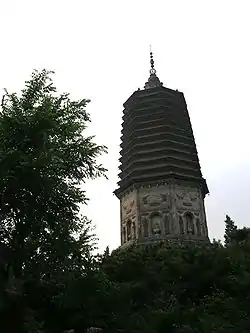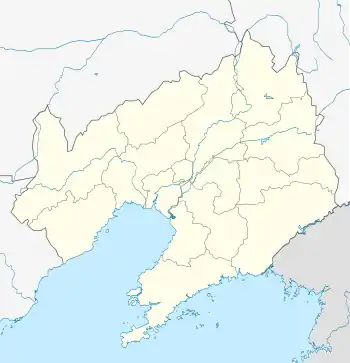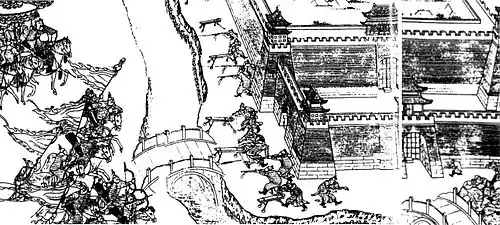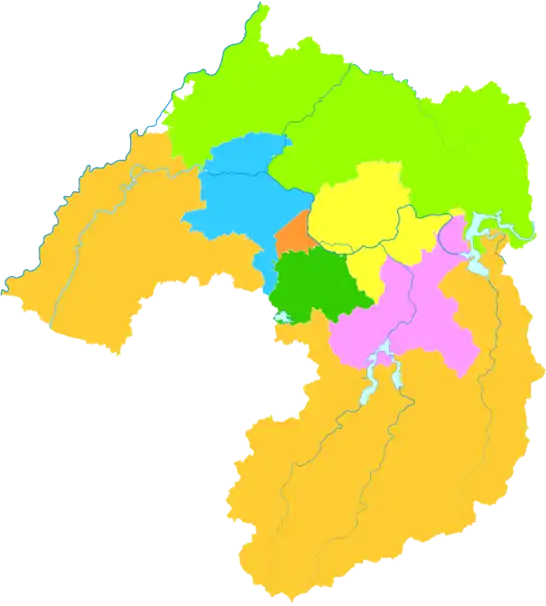Liaoyang
Liaoyang (simplified Chinese: 辽阳; traditional Chinese: 遼陽; pinyin: Liáoyáng) is a prefecture-level city of east-central Liaoning province, China, situated on the Taizi River. It is approximately one hour south of Shenyang, the provincial capital, by car. Liaoyang is home to Liaoning University's College of Foreign Studies and a number of vocational colleges. The city hosts a limited number of professional basketball and volleyball games in a modern sports facility. According to the latest statistics in 2020, the age distribution of the population in Liaoyang is as follows: 0-14 years old account for 9.83% of the population; 15-59 years old account for 62.26% of the population; 60 years old and above account for 27.91% of the population; 65 years old and above account for 19.46% of the population.[2]
Liaoyang
辽阳市 | |
|---|---|
 White Pagoda (Baita) in Liaoyang | |
.png.webp) Location of Liaoyang City jurisdiction in Liaoning | |
 Liaoyang Location of the city centre in Liaoning | |
| Coordinates (Baita Park (白塔公园)): 41°16′44″N 123°10′34″E | |
| Country | People's Republic of China |
| Province | Liaoning |
| Municipal seat | Baita District |
| Districts | List
|
| Government | |
| • CPC Secretary | Wang Fengbo |
| • Mayor | Pei Weidong |
| Area | |
| • Prefecture-level city | 4,710 km2 (1,820 sq mi) |
| • Metro | 3,997.8 km2 (1,543.6 sq mi) |
| Elevation | 29 m (95 ft) |
| Population (2020 census)[1] | |
| • Prefecture-level city | 1,604,580 |
| • Density | 340/km2 (880/sq mi) |
| • Urban | 877,832 |
| Time zone | UTC+8 (China Standard) |
| Postal code | 111000 |
| Area code | 419 |
| ISO 3166 code | CN-LN-10 |
| Licence plates | 辽K |
| Administrative division code | 211000 |
| Website | www |
History

Liaoyang is one of the oldest continuously-inhabited cities in northeast China, dating back to before the Warring States period, and the site of the city has not changed ever since.[3] Under the Yan state and the Qin and Han dynasties, Liaoyang (then known as Xiangping) was the capital of Liaodong Commandery and the political center of the Liaodong region. During the Three Kingdoms period, the city was the focus of Sima Yi's devastating Liaodong campaign. From the 5th to 7th centuries, Liaoyang was on the northern edge of the Goguryeo kingdom. Remains of Yodong and Baegam, the old Goguryeo cities, can still be seen near the modern city. This was the site of a major battle between the Tang and Goguryeo in 645 AD.
Liaoyang rose to prominence during the Liao dynasty. Several buildings in the city date to this period. Among these is the White Pagoda (baita), which dates back to 1189 in the Liao Dynasty with additions during the Yuan dynasty.[4] The Liaoyang White Pagoda sits in Baita Park within Baita district in the centre of the city. Next to the park is Guangyou Temple, one of the oldest and largest temple complexes in the north east of China covering some 60,000 square metres (650,000 sq ft).
Under the Jurchen Jin dynasty, the city served as their empire's eastern capital under the name Dongjing (東京).[5]
In the 17th century, the Manchu people rose up against the Ming dynasty of China. Liaoyang was one of the first Ming cities to fall and Nurhaci, the new Emperor of the Later Jin dynasty, made his capital there naming the city Dongjing in 1621. He also moved the tombs of several family members to Liaoyang and they can still be seen in Dongjingling, just east of the city. As the Manchu expanded, they again moved the capital to Shenyang in 1625. After this Dongjing faded in importance. Today, remains of the city walls can still be seen and a small museum stands within the reconstructed south gate.
The year 1900 saw the Boxer Rebellion in China. Russian troops camped in Liaoyang city, burning the ancient Guangyou temple. On the August 24 September 1904, the Battle of Liaoyang took place. This was a major battle of the Russo-Japanese war.
Liaoyang was one of the major centres of the Manchurian revival, a Protestant Christian revival which took place in Mukden (Shenyang) and the surrounding countryside in 1908.
The city was the site of widespread labor protests in March 2002 that were sparked by the bankruptcy and subsequent liquidation of the Liaoyang Ferroalloy Factory, or Liaotie. The protesters were workers from at least seven different factories, including failing textile, chemical, piston, instruments, leather, and precision tool plants. Their grievances involved local government corruption and widespread worker layoffs coupled with arrearage in employee wages, pensions and unemployment benefits. The activists demanded compensation for what they were owed, an investigation into the bankruptcy of Liaotie, and the resignation of the chairman of the local legislature, Gong Shangwu. The protests were eventually dispersed after several days by the government after declaring a curfew under martial law. Two of the workers' representatives, Xiao Yunliang and Yao Fuxin, were given prison terms of four and seven years, respectively. The government also responded by paying most but not all of the money that the workers were owed, and by ordering an investigation into the charges of corruption at Liaotie which culminated in the arrest and thirteen-year prison sentence of its manager, Fan Yicheng, for smuggling and fraudulent dereliction of duty. The provincial governor who approved the Liaotie bankruptcy was also imprisoned for accepting bribes, but Gong Shangwu evaded punitive action.[6]
Administrative divisions
Within Liaoyang prefecture there are one county, five districts and one city.[7]
| Map | ||||||
|---|---|---|---|---|---|---|
| # | Name | Chinese | Hanyu Pinyin | Population (2003 est.) | Area (km²) | Density (/km²) |
| 1 | Baita District | 白塔区 | Báitǎ Qū | 210,000 | 24 | 8,750 |
| 2 | Wensheng District | 文圣区 | Wénshèng Qū | 180,000 | 38 | 4,737 |
| 3 | Hongwei District | 宏伟区 | Hóngwěi Qū | 110,000 | 59 | 1,864 |
| 4 | Gongchangling District | 弓长岭区 | Gōngchánglǐng Qū | 90,000 | 288 | 313 |
| 5 | Taizihe District | 太子河区 | Tàizǐhé Qū | 120,000 | 148 | 811 |
| 6 | Dengta City | 灯塔市 | Dēngtǎ Shì | 510,000 | 1,331 | 383 |
| 7 | Liaoyang County | 辽阳县 | Liáoyáng Xiàn | 590,000 | 2,853 | 207 |
Geography and climate
| Climate data for Liaoyang (1991–2020 normals, extremes 1981–2010) | |||||||||||||
|---|---|---|---|---|---|---|---|---|---|---|---|---|---|
| Month | Jan | Feb | Mar | Apr | May | Jun | Jul | Aug | Sep | Oct | Nov | Dec | Year |
| Record high °C (°F) | 9.3 (48.7) |
18.0 (64.4) |
21.2 (70.2) |
29.8 (85.6) |
35.5 (95.9) |
37.0 (98.6) |
36.2 (97.2) |
35.8 (96.4) |
33.2 (91.8) |
29.4 (84.9) |
21.2 (70.2) |
13.2 (55.8) |
37.0 (98.6) |
| Average high °C (°F) | −3.6 (25.5) |
1.1 (34.0) |
8.3 (46.9) |
17.6 (63.7) |
24.3 (75.7) |
28.0 (82.4) |
29.9 (85.8) |
29.1 (84.4) |
24.9 (76.8) |
17.1 (62.8) |
6.9 (44.4) |
−1.1 (30.0) |
15.2 (59.4) |
| Daily mean °C (°F) | −9.8 (14.4) |
−4.8 (23.4) |
2.7 (36.9) |
11.6 (52.9) |
18.4 (65.1) |
22.8 (73.0) |
25.4 (77.7) |
24.3 (75.7) |
18.6 (65.5) |
10.7 (51.3) |
1.4 (34.5) |
−6.8 (19.8) |
9.5 (49.2) |
| Average low °C (°F) | −15.1 (4.8) |
−10.3 (13.5) |
−2.8 (27.0) |
5.4 (41.7) |
12.4 (54.3) |
17.5 (63.5) |
21.1 (70.0) |
19.9 (67.8) |
12.8 (55.0) |
4.8 (40.6) |
−3.6 (25.5) |
−11.8 (10.8) |
4.2 (39.5) |
| Record low °C (°F) | −35.6 (−32.1) |
−34.9 (−30.8) |
−19.8 (−3.6) |
−12.1 (10.2) |
−2.1 (28.2) |
5.4 (41.7) |
12.5 (54.5) |
8.3 (46.9) |
−0.3 (31.5) |
−8.9 (16.0) |
−24.7 (−12.5) |
−27.1 (−16.8) |
−35.6 (−32.1) |
| Average precipitation mm (inches) | 6.6 (0.26) |
9.8 (0.39) |
16.2 (0.64) |
34.5 (1.36) |
61.2 (2.41) |
94.2 (3.71) |
153.6 (6.05) |
178.4 (7.02) |
61.0 (2.40) |
46.3 (1.82) |
26.3 (1.04) |
11.5 (0.45) |
699.6 (27.55) |
| Average precipitation days (≥ 0.1 mm) | 3.4 | 3.2 | 4.4 | 6.7 | 9.2 | 10.8 | 12.0 | 11.2 | 7.1 | 6.5 | 5.5 | 4.0 | 84 |
| Average snowy days | 4.9 | 4.4 | 4.0 | 1.1 | 0 | 0 | 0 | 0 | 0 | 0.5 | 4.3 | 5.3 | 24.5 |
| Average relative humidity (%) | 61 | 54 | 49 | 47 | 52 | 64 | 75 | 77 | 71 | 64 | 62 | 62 | 62 |
| Mean monthly sunshine hours | 164.7 | 178.4 | 218.5 | 224.5 | 248.6 | 213.6 | 182.4 | 189.4 | 218.4 | 196.2 | 151.0 | 146.4 | 2,332.1 |
| Percent possible sunshine | 55 | 59 | 59 | 56 | 55 | 47 | 40 | 45 | 59 | 58 | 51 | 51 | 53 |
| Source: China Meteorological Administration[8][9] | |||||||||||||
Tourism
The largest park within the city is Baita park. There are several historical sites to be visited. The new Liaoyang Museum, open to the public since 2009, contains many antiques. Guangyou temple beside the Baita (White Pagoda) has become one of Liaoyang's main tourism attraction in recent years. The first temple on the site dates back to 1145. The temple was destroyed by Russian troops during the 1900 Boxer Rebellion but was later rebuilt.[10] It houses a giant statue of Buddha made from sandalwood. There are two small museums for famous Liaoyang residents: Cao Xueqin, author of the book Dreams of a Red Mansion, and Wang Erlie, a notable Qing dynasty official. There is also a small museum just outside the city on the site of Dongjing, the old capital city. Gongchangling County, just east of the main city is noted for its hot spring resort, golf course and ski centre. Outdoor activities include the Tanghe River, Shenwo Reservoir Scenic Area and rafting on the Taizi river.[11] In the downtown area busy shopping malls can be found. The shopping area includes a total of five malls and pedestrianized streets with many Chinese brand name stores. On the streets, there are many interesting and delicious regional snacks. Within the shopping area are two streets with many Korean BBQ restaurants (Er-dao jie, Xingyun da jie).
Military
Liaoyang is the headquarters of the 39th Mechanized Group Army of the People's Liberation Army, one of the three group armies that comprise the Shenyang Military Region responsible for defending China's northeastern borders with Russia and North Korea.
International relations
Twin towns — sister cities
Liaoyang is twinned with:
Notable residents
- Cao Xueqin, the author of Dream of the Red Chamber (红楼梦; hóng lóu mèng)
- Wang Erlie, a notable Qing dynasty official
- Toshiko Akiyoshi (秋吉 敏子 / 穐吉 敏子, Akiyoshi Toshiko), Japanese jazz pianist, born in Liaoyang in 1929
- Wang Junfeng, President of the All China Lawyers Association
References
- "China: Liáoníng (Prefectures, Cities, Districts and Counties) - Population Statistics, Charts and Map".
- "辽宁省统计局". tjj.ln.gov.cn. Retrieved 2022-04-28.
- "国务院正式批复!辽阳成为第135座国家历史文化名城". thepapaer.cn. 7 December 2020.
- "Baida White Pagoda Park Travel Guide". A Book About China. Retrieved 26 March 2012.
- Theobald, Ulrich. China Knowledge. "Chinese History - Jin Dynasty 金 (1115-1234): Map and Geography". Accessed 19 Oct 2012.
- Philip P. Pan, Out of Mao's Shadow, 2008: Simon and Schuster. (ISBN 1416537058)
- Liaoyang Municipal Government (2007-07-03). 辽阳市人民政府网站 (in Chinese). Archived from the original on 2007-10-15. Retrieved 2008-05-30.
- 中国气象数据网 – WeatherBk Data (in Simplified Chinese). China Meteorological Administration. Retrieved 29 July 2023.
- 中国气象数据网 (in Simplified Chinese). China Meteorological Administration. Retrieved 29 July 2023.
- "Guangyou Temple Scenic Area Travel Guide". A Book About China. Retrieved 26 March 2012.
- "Liaoyang Travel Guide". A Book About China. Retrieved 26 March 2012.
